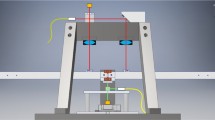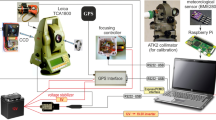Abstract
The characteristics of a pre-flight model of the Skylab BMMD (Body Mass Measurement Device), which was made around 1970 by the team led by Dr. William Thornton, are accurately evaluated using an optical interferometer on ground. The calibration of the BMMD is conducted using metal block weights in the range of the total mass of 4.134 kg to 100.131 kg, in which the RMS value of the differences between the regression line and the calibrated values are 0.018 kg. Using this calibration result, the BMMD estimates the masse values of human subjects in the range of 33.16 kg to 95.79 kg with the standard uncertainty of 0.21 kg, which corresponds to 0.2% of the maximum value of the mass of the human subjects. It is found that the oscillation of BMMD seat is disturbed even with quiet breathing of the subject human. This is considered to be caused by the relative change of the center of mass of the human body due to the movement of internal organs.






Similar content being viewed by others
References
Bradamante, S., Rivero, D., Barenghi, L., et al.: SCD – stem cell differentiation toward osteoblast onboard the international Space Station. Microgravity Sci. Technol. 30, 713–729 (2018)
Campbell, M., Charles, J.: Dr. William Thornton and the Development of the Mass Measurement Device for Spaceflight. Aerosp. Med. and Hum. Perform. 90, 6 (2019)
Fujii, Y., Fujimoto, H., Namioka, S.: Mass measurement under weightless conditions. Rev. Sci. Instrum. 70, 111–113 (1999)
Fujii, Y., Shimada, K., Maru, K.: Instrument for measuring the body mass of astronauts under microgravity conditions. Microgravity Sci. and Technol. 22, 115–121 (2010)
Ivanova, K., Eiermann, P., Tsiockas, W., et al.: Differential regulation of cGMP signaling in human melanoma cells at altered gravity: simulated microgravity Down-regulates cancer-related gene expression and motility. Microgravity Sci. Technol. 30, 457–467 (2018)
Okoro, E., Mann, V., Ellis, I., et al.: Immune modulation in Normal human peripheral blood mononuclear cells (PBMCs) (lymphocytes) in response to Benzofuran-2-carboxylic acid derivative KMEG during spaceflight. Microgravity Sci. Technol. 29, 331–336 (2017)
Ritzmann, R., Krause, A., Freyler, K., et al.: Gravity and neuronal adaptation. Microgravity Sci. Technol. 29, 9–18 (2017)
Rivetti, A., Martini, G., Alasia, F., Piana, G., Gatti, L.: BIC 3, the latest inertial centrifugal balance for mass measurement in weightless conditions. Microgravity Sci. and Technol. 20, 7–15 (2008)
Sarychev, V.A., et al.: Measurement of mass under weightless condition. KOSM. ISSLED (USSR). 18, 536–549 (1980) (in Russian)
Smith, D.C., Kaufman, K.A.: Space Linear Acceleration Mass Measurement Device (THE SLAMMD) for the Human Research Facility (HRF). SAE Technical Papers. 981652 (1998)
Sundaresan, A., Mehta, S.K., Schlegel, T.T., et al.: Placental growth factor levels in populations with high versus low risk for cardiovascular disease and stressful physiological environments such as microgravity: a pilot study. Microgravity Sci. Technol. 29, 145–149 (2017)
Thornton, W., Ord, J.: pecimen mass measurement. NASA Tech. Rep. N74–N11867 (1974)
Thornton, W., Ord, J.: Physiological mass measurements on Skylab 1/2 and 1/3. Acta Astronautica. 2, 103–113 (1975)
Zhu, H., Wang, H., Li, D., et al.: Evaluation of the human thermal comfort under simulated weightlessness: an experimental study based on the power Spectrum analysis of the heart rate variability. Microgravity Sci. Technol. 31, 9–18 (2019)
Acknowledgments
The authors thank the Master-course students of Gunma University, who helped in the experiment, especially Mr. K. Suzuki and K. Nakaya.
Author information
Authors and Affiliations
Corresponding author
Additional information
Publisher’s Note
Springer Nature remains neutral with regard to jurisdictional claims in published maps and institutional affiliations.
Rights and permissions
About this article
Cite this article
Fujii, Y., Shimada, K., Takita, A. et al. Evaluation of the Dr. William Thornton’s Skylab BMMD. Microgravity Sci. Technol. 32, 275–280 (2020). https://doi.org/10.1007/s12217-019-09762-2
Received:
Accepted:
Published:
Issue Date:
DOI: https://doi.org/10.1007/s12217-019-09762-2




